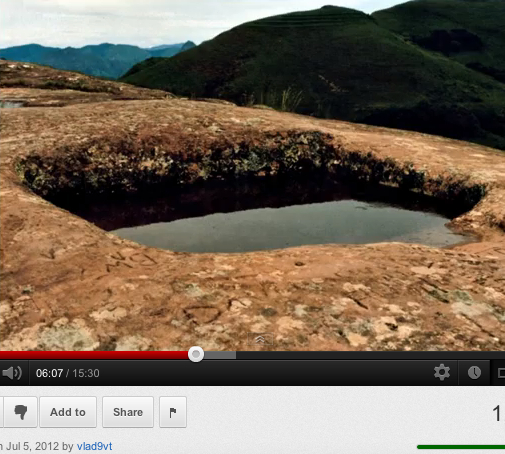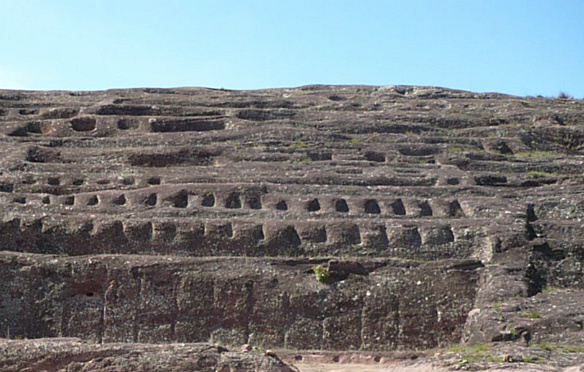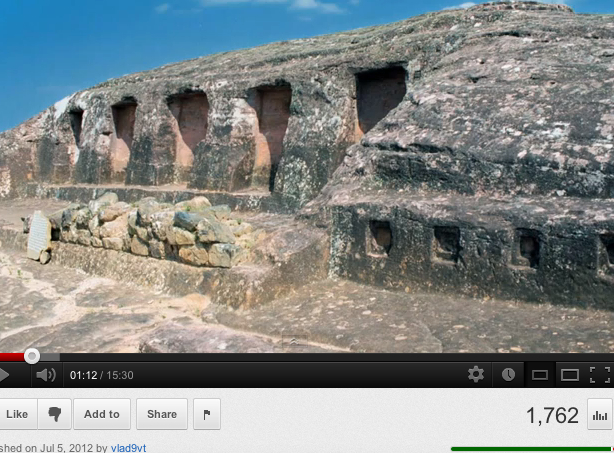It looks like you're using an Ad Blocker.
Please white-list or disable AboveTopSecret.com in your ad-blocking tool.
Thank you.
Some features of ATS will be disabled while you continue to use an ad-blocker.
share:
reply to post by weemadalex
I was just thinking that. Imagine if a a mother ship landed and they tried to recreate it in stone.....
I was just thinking that. Imagine if a a mother ship landed and they tried to recreate it in stone.....
The questions are profound, but profound questions are beautiful like a woman who knows how to retain some ever-intriguing mystery.
It didn't cross my mind as I was reading and looking at the pics, but the minute you said it, it was like a lightbulb. I bet you're right.
Thanks, brother, this thread was a very welcome and right on time mind-journey.
These last two images show signs in my opinion of the site being used at one time as either a quarry or possible a location where young stone carvers may have learned, practiced and perfected their trade.
It didn't cross my mind as I was reading and looking at the pics, but the minute you said it, it was like a lightbulb. I bet you're right.
Thanks, brother, this thread was a very welcome and right on time mind-journey.
I've always thought the parallel grooves look like some sort of wheel guiding track for a slingshot/catapult powered glider. We've all seen the
Egyptian model "glider" so why not eh?
The mechanism/grooves could launch a glider almost directly east, out over a valley towards the rising sun...
anyways, S & F
The mechanism/grooves could launch a glider almost directly east, out over a valley towards the rising sun...
anyways, S & F
edit on 22-9-2012 by Funk bunyip because: (no reason given)
Well thanks for the replies. Great contributions and questions
reply to post by SLAYER69
Great post - thank you. I looked at the doorways - all in a straight line - on the bottom of what appears to be a building. I thought that perhaps there was something in each doorway?? Perhaps metallic or mineral or crystalline that reflected or acted as a conductor????
The two grooves are interesting and I thought perhaps they were not finished and there was more to them. In archaeology sometimes sites seem to have the appearance that some 'sudden' event took place - this was my first thought when I looked at the photographs you posted.
Just my thoughts.
Much Peace...
Great post - thank you. I looked at the doorways - all in a straight line - on the bottom of what appears to be a building. I thought that perhaps there was something in each doorway?? Perhaps metallic or mineral or crystalline that reflected or acted as a conductor????
The two grooves are interesting and I thought perhaps they were not finished and there was more to them. In archaeology sometimes sites seem to have the appearance that some 'sudden' event took place - this was my first thought when I looked at the photographs you posted.
Just my thoughts.
Much Peace...
Gotta love those ancient astronaught theorists. Rather than believe the ingenuity of mankind could make an advanced civilzation prior to the one we
have now, to them it was obviously made by aliens :shk:. Look at the leap we made in the last 100 years. If we could do what we have now, then mankind
did this before because history repeats itself in loops.
Or you could believe this guy:

Or you could believe this guy:

The overhead view looks a lot like the layout of modern day airports.
In the second picture, those grooves are located on a slopped part of the mountain.The highest end of the slope with the grooves in it ends at the edge of the mountain where it drops off.
Since none of the wood survived it`s possible that those grooves and other cutouts in the rocks were used as notches to hold wooden beams in place.
interesting looking place.
In the second picture, those grooves are located on a slopped part of the mountain.The highest end of the slope with the grooves in it ends at the edge of the mountain where it drops off.
Since none of the wood survived it`s possible that those grooves and other cutouts in the rocks were used as notches to hold wooden beams in place.
interesting looking place.
reply to post by Tardacus
The overview is pretty fascinating.
It looks more like some sort of mechanism...
The overview is pretty fascinating.
It looks more like some sort of mechanism...
reply to post by SLAYER69
Its a water works.
From the YouTube video:

Thats a cistern. It still captures the rain and stores it to this day. See the "outflow" on the downward side?
It would hold water for crops on the hillsides around there and be doled out during dry periods. Looks like good farming land. That stone hilltop would catch a lot of rainwater and direct it down the mountain on all sides from the various "facets" and channels carved in it.
These people were smart. Their lives depended on the harvest to make it to the next year. Insuring maximum usage of rain water would be key to their survival. The alternative would be to haul it up the hill from river beds at the bottom of the valleys below. Why not let it run down to the various fields and dwellings around the mountain top?
I could imagine when it rained everyone ran up the hill to monitor the flow and direct it to the right place, running along the various channels, clearing clogs, opening and closing sluice gates. Filling every row and furlough of their fields as much as possible. Then storing as much as they could in the cisterns.
This complex system of water runoff was probably decades in the making and carefully controlled by the local Powers That Be. Water rights are a big deal even today.
Its a water works.
From the YouTube video:

Thats a cistern. It still captures the rain and stores it to this day. See the "outflow" on the downward side?
It would hold water for crops on the hillsides around there and be doled out during dry periods. Looks like good farming land. That stone hilltop would catch a lot of rainwater and direct it down the mountain on all sides from the various "facets" and channels carved in it.
These people were smart. Their lives depended on the harvest to make it to the next year. Insuring maximum usage of rain water would be key to their survival. The alternative would be to haul it up the hill from river beds at the bottom of the valleys below. Why not let it run down to the various fields and dwellings around the mountain top?
I could imagine when it rained everyone ran up the hill to monitor the flow and direct it to the right place, running along the various channels, clearing clogs, opening and closing sluice gates. Filling every row and furlough of their fields as much as possible. Then storing as much as they could in the cisterns.
This complex system of water runoff was probably decades in the making and carefully controlled by the local Powers That Be. Water rights are a big deal even today.
reply to post by intrptr
That makes sense, and since they didn`t have pumps,by building this on top of a mountain they could use gravity to move the water down to where it was needed.
That makes sense, and since they didn`t have pumps,by building this on top of a mountain they could use gravity to move the water down to where it was needed.
reply to post by intrptr
Could be. I tried to point out in the OP that it probably had many uses over it's history. That sure could be one Now, how do the vertical square cut out carvings around the base apply to that idea?
Could be. I tried to point out in the OP that it probably had many uses over it's history. That sure could be one Now, how do the vertical square cut out carvings around the base apply to that idea?
Originally posted by intrptr
reply to post by SLAYER69
Its a water works.
From the YouTube video:
Thats a cistern. It still captures the rain and stores it to this day. See the "outflow" on the downward side?
It would hold water for crops on the hillsides around there and be doled out during dry periods. Looks like good farming land. That stone hilltop would catch a lot of rainwater and direct it down the mountain on all sides from the various "facets" and channels carved in it.
These people were smart. Their lives depended on the harvest to make it to the next year. Insuring maximum usage of rain water would be key to their survival. The alternative would be to haul it up the hill from river beds at the bottom of the valleys below. Why not let it run down to the various fields and dwellings around the mountain top?
I could imagine when it rained everyone ran up the hill to monitor the flow and direct it to the right place, running along the various channels, clearing clogs, opening and closing sluice gates. Filling every row and furlough of their fields as much as possible. Then storing as much as they could in the cisterns.
This complex system of water runoff was probably decades in the making and carefully controlled by the local Powers That Be. Water rights are a big deal even today.
Great post, great concept. I think you may be correct (or, as Slayer points out, partially correct).
And to answer Slayers question about the "doors"...perhaps that is part of the religious aspect of it all. Meso cultures were notorious for having cults related to nature (primarily sun and rain) and agriculture.
Who knows...but that looks like a cistern to me too. And there are ample cisterns from the period, if i recall correctly, peppered through central and south America.
Originally posted by SLAYER69
reply to post by Tardacus
The overview is pretty fascinating.
It looks more like some sort of mechanism...
I was thinking channels for water to power a water wheel. The water wheel could be used to power many things mechanical.
Being that the local culture may have been based on farming and rainfall, the water wheel cold have been used to power crop related machinery?
Also with all of the stone mason evidence, the water wheel could of been used to power masonry machinery such as drills or saws?
Originally posted by RobertF
I was thinking channels for water to power a water wheel. The water wheel could be used to power many things mechanical.
Being that the local culture may have been based on farming and rainfall, the water wheel cold have been used to power crop related machinery?
Also with all of the stone mason evidence, the water wheel could of been used to power masonry machinery such as drills or saws?
That would require a fair amount of consistent water/rain fall to be of any use.
No?
Originally posted by SLAYER69
Originally posted by RobertF
I was thinking channels for water to power a water wheel. The water wheel could be used to power many things mechanical.
Being that the local culture may have been based on farming and rainfall, the water wheel cold have been used to power crop related machinery?
Also with all of the stone mason evidence, the water wheel could of been used to power masonry machinery such as drills or saws?
That would require a fair amount of consistent water/rain fall to be of any use.
No?
It would but if you supplemented it with water from the cisterns the the other poster pointed out it might work?
reply to post by RobertF
They're not very big though.
I'm not denying they hold water and may have been used as such but to put it that use would require a great deal more than is provided by such a small reservoir
They're not very big though.
I'm not denying they hold water and may have been used as such but to put it that use would require a great deal more than is provided by such a small reservoir
Originally posted by SLAYER69
reply to post by intrptr
Could be. I tried to point out in the OP that it probably had many uses over it's history. That sure could be one Now, how do the vertical square cut out carvings around the base apply to that idea?
I was going to cover that but wanted to wait and see what others thought of the idea. Look at these photos you brought.


From this angle it appears to me to be a trickle down from above. In line "boxes" and "channels" all the way to the bottom where rivulets are carved in the rock side by side. In the top pic there appears to be a walkway ramp (center photo) and pathways from that to the left and right. Each row of boxes or channels is aligned above and below the next "step" all the way to the top like a stairway?
So I am ass/u/me-ing that that is some kind of run off control for each of the channels to the bottom of the picture. Surely it is missing pieces (like funnels or gates) and has become very weathered over the centuries. It is out of tune. I wonder what would happen if you carried a bucket of water to the top and poured it down some of those tracks?
About these cutouts or "boxes".

Now I am going to go way out there. The large "boxes" appear to be undercut. They look like "blackened" at the bottom and blanched above... could that have been a place to catch water in containers of some sort and heat it with fires? For hot running water? I know, I know. But explain the blackened base and the "steam cleaned" appearance in those nooks. Who knows? Each rivulet could have been designed to send water to the dwellings right below them. Today this matrix of complex water channeling would be a manifold of plumbing pipe branching out underground to each house in your neighborhood.
Don't really know either way about all that, just grimacing at the photos, trying to see the "practical" application they must have had in mind. The only other thing I came up with was those nooks were for their deceased. Like a cemetery. The big ones for their dead, buried "standing up" and the small nooks for containers of ashes? Then there are tiers or places for coffins all the way up. But I don't know about that. That seems less likely.
reply to post by intrptr
I appreciate your thread participation. Great thought process.
I'm open to all theories.
I appreciate your thread participation. Great thought process.
I'm open to all theories.
Originally posted by SLAYER69
reply to post by RobertF
They're not very big though.
I'm not denying they hold water and may have been used as such but to put it that use would require a great deal more than is provided by such a small reservoir
Yeah you are probably right. It was a shot in the dark idea.
reply to post by SLAYER69
Not if this was a dual system. One part is active. It is channeling and distributing water while it is raining. The other is a storage and re-distribution system for on demand.
And it does rain a lot there right? Even cloudy days might fog bank the hills with condensation enough to flow into cisterns. If the altitude is high enough.
That would require a fair amount of consistent water/rain fall to be of any use.
No?
Not if this was a dual system. One part is active. It is channeling and distributing water while it is raining. The other is a storage and re-distribution system for on demand.
And it does rain a lot there right? Even cloudy days might fog bank the hills with condensation enough to flow into cisterns. If the altitude is high enough.
new topics
-
Secretary of Defense - Lots of Attention Since Pete Hegseth was Nominated to Fill The Position.
US Political Madness: 46 minutes ago -
Manhunt For Killer Gunman After CEO Shot Dead In New York
Mainstream News: 1 hours ago -
Ukraine Style war would mean UK forces would be done in 6 months
World War Three: 2 hours ago -
Why Pardon Hunter ? Why risk the fallout?
Political Issues: 3 hours ago -
Disney’s Snow White | Official Trailer | In Theaters March 21
Movies: 5 hours ago -
UnitedHealthcare CEO Brian Thompson shot dead in Midtown Manhattan, masked gunman at large
Other Current Events: 5 hours ago -
More NY Justice System Corruption
Social Issues and Civil Unrest: 10 hours ago
top topics
-
More NY Justice System Corruption
Social Issues and Civil Unrest: 10 hours ago, 18 flags -
UnitedHealthcare CEO Brian Thompson shot dead in Midtown Manhattan, masked gunman at large
Other Current Events: 5 hours ago, 9 flags -
Would Democrats Be in Better Shape if They Had Replaced Joe Biden with Kamala Harris in July 2024.
US Political Madness: 17 hours ago, 7 flags -
Disney’s Snow White | Official Trailer | In Theaters March 21
Movies: 5 hours ago, 3 flags -
Secretary of Defense - Lots of Attention Since Pete Hegseth was Nominated to Fill The Position.
US Political Madness: 46 minutes ago, 3 flags -
Why Pardon Hunter ? Why risk the fallout?
Political Issues: 3 hours ago, 2 flags -
Ukraine Style war would mean UK forces would be done in 6 months
World War Three: 2 hours ago, 1 flags -
Manhunt For Killer Gunman After CEO Shot Dead In New York
Mainstream News: 1 hours ago, 1 flags
active topics
-
Secretary of Defense - Lots of Attention Since Pete Hegseth was Nominated to Fill The Position.
US Political Madness • 2 • : Hypntick -
Ukraine Style war would mean UK forces would be done in 6 months
World War Three • 8 • : Tolkien -
UnitedHealthcare CEO Brian Thompson shot dead in Midtown Manhattan, masked gunman at large
Other Current Events • 25 • : tamusan -
CIA Whistleblower Kevin Shipp claims CIA was involved in MH370's disappearance
General Conspiracies • 20 • : Guyfriday -
Why Pardon Hunter ? Why risk the fallout?
Political Issues • 9 • : marg6043 -
The Final Experiment is Scheduled for December 2024. Will it Finally Answer the Question?
Science & Technology • 37 • : KnowItAllKnowNothin -
Russian Disinformation Campaign Claims Stalker 2 Is Used To Locate Ukraine War Conscripts
Mainstream News • 7 • : Tolkien -
Salvatore Pais confirms science in MH370 videos are real during live stream
General Conspiracies • 103 • : Lazy88 -
Alien warfare predicted for December 3 2024
Aliens and UFOs • 92 • : angelchemuel -
Manhunt For Killer Gunman After CEO Shot Dead In New York
Mainstream News • 1 • : nugget1
